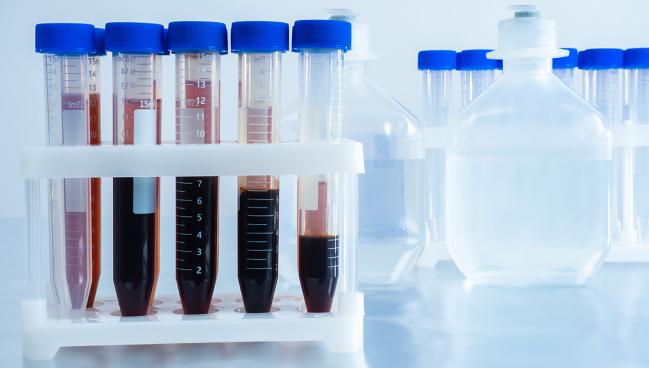Higher Single-Sample hs-cTnT Threshold Can Safely Exclude MI
FDA rules require testing a hs-cTnT cutoff of 6 ng/L, not the 5 ng/L used in European studies. The good news is it still works.

The unique aspect of the study, published May 10, 2022, in Circulation, is that investigators showed a hs-cTnT concentration of less than 6 ng/L was safe to rapidly triage and identify patients without acute myocardial infarction. When combined with a normal ECG, the strategy of using a single hs-cTnT measurement < 6 ng/L had excellent negative predictive value (NPV) for ruling out acute MI.
“For practices like us that haven’t yet made the change [to single-sample rule-out], or were on the fence about making the change, this provides new evidence and we’re now having conversations about making the change to allowing a single-sample rule-out,” lead investigator Yader Sandoval, MD (Mayo Clinic, Rochester, MN), told TCTMD.
Senior investigator Allan Jaffe, MD (Mayo Clinic), also endorsed the single hs-cTnT measurement—and the higher threshold—for identifying potential patients who may be safely sent home.
“You don’t want to put a patient in the corner and ignore them—for example, just looking at their troponins and ignoring them clinically—but assuming clinicians are thoughtful, this is a good strategy, and we’re making plans to implement this at Mayo Clinic sites,” Jaffe told TCTMD. “There’s about 30%, or maybe even as many as 40% of patients, who could be sent home if the only question is whether they’re having a heart attack predicated on the use of this strategy.”
Problems Caused by FDA Rules
Clinical guidelines endorse the use of algorithms that allow physicians to rule out acute MI when a single-sample hs-cTn value is very low. This has been implemented by many centers with assays that have been validated to manifest a high NPV. As per the European Society of Cardiology guidelines, this occurs with hs-cTnT when concentrations fall below limit of detection (LoD), which is 5 ng/L for that assay. Even the American College of Cardiology/American Heart Association support using the LoD for excluding myocardial injury for patients with suspected ACS with symptom onset at least 3 hours prior to presentation.
The US Food and Drug Administration, however, does not allow manufacturers to report the LoD for clinical use. Instead, the lowest reportable concentration for hs-cTnT per the FDA clearance is known as the level of quantification (LoQ), which is less than 6 ng/L, a threshold that hasn’t been extensively studied.
“There are a large number of data that substantiate the fact that very low values [hs-cTnT] can be used to exclude the likelihood of acute myocardial infarction,” said Jaffe. “The question here is whether using a value of 6 ng/L, which is the lowest value the FDA will allow you to report, works. When we first started to implement high-sensitivity troponin, we were cynical.”
To date, there isn’t a lot of US evidence to support the higher hs-cTnT value for ruling out acute MI. For this reason, the Mayo Clinic hasn’t endorsed the single-sample strategy given the lack of data with the higher threshold.
Almost one-third of patients overall would qualify for this rapid rule-out strategy. Yader Sandoval
“In creates a bit of a conundrum,” Sandoval told TCTMD. “The guidelines in Europe, and the practice in Europe, allows them to report down to the LoD, which is less than 5 ng/L. For that particular threshold, there is a wealth of data showing that it is pretty safe—if your value is less than 5 ng/L, your ECG is normal, and you’re not having symptoms at that point in time, or for more than 2 or 3 hours, you can probably go home and exclude a heart attack with a good degree of confidence.”
While there were small studies suggesting that evaluating hs-cTnT below the LoQ threshold of 6 ng/L could be used to rule-out MI, these studies were largely inconclusive or lacked an adequate gold-standard assay, said Jaffe. Some of those studies used different criteria for acute MI that wouldn’t be applicable to US practices. There were even studies suggesting that the LoQ may not be safe for ruling out acute MI, he said.
“It might appear to be a small difference,” said Sandoval, referring to difference in hs-cTnT reporting concentrations. “From an analytical perspective, they’re completely different thresholds.”
‘It Was Highly Effective’
To answer their question, researchers turned to the Cardiovascular Data Mart Biomarker Cohort, which included 85,610 adult patients (mean age 63 years; 50% female) who presented to one of the Mayo Clinic emergency departments (EDs) and had at least one hs-cTnT measurement within 12 hours of presentation. At the time these patients presented, the Mayo Clinic EDs had adopted hs-cTnT testing but weren’t using a single-sample rule-out strategy. Hs-cTnT was measured using the Elecsys Troponin T Gen 5 STAT assay (Roche Diagnostics) with concentrations reported to the LoQ.
Of the cohort, 29% had hs-cTnT levels less than 6 ng/L, and these individuals tended to be younger and were more likely to have comorbidities compared with those with quantifiable hs-cTnT concentrations. Women more likely than men to have baseline hs-cTnT values < 6 ng/L. The percentage of patients with hs-cTnT concentrations < 6 ng/L was consistent across the multiple EDs, which suggests the results are generalizable beyond the present study population.
“Almost one-third of patients overall would qualify for this rapid rule-out strategy,” said Sandoval.
Assuming clinicians are thoughtful, this is a good strategy, and we’re making plans to implement this at Mayo Clinic sites. Allan Jaffe
To first identify low-risk patients by excluding acute myocardial injury (a value above the sex-specific 99th percent upper reference limit), researchers evaluated 11,962 patients with a baseline hs-cTnT < 6 ng/L with serial measurements. Acute myocardial injury, which was defined as any subsequent increase in hs-cTnT above the sex-specific 99th percentile during the first 24 hours, occurred in 1.2% of these patients, resulting in a negative predictive value (NPV) of 98.8% and a sensitivity of 99.6%. Similar findings were observed in patients with chest pain. In men, the NPV and sensitivity was 99.3% and 99.8%, respectively. In women, it was 98.5% and 99.3% in women, respectively.
“It was highly effective,” said Jaffe. “The frequency of finding such people who had values above the 99th percentile was quite tiny. The only one area where there might have been question in our analysis was in older women with heart failure. We then augmented our findings because we [initially] used ICD codes, which are less accurate than if you go through and adjudicate every patient.”
Adjudication Cohort of ED Patients
This adjudication cohort included 1,849 ED patients. This allowed researchers to directly evaluate their clinical rule-out strategy, one that combined a nonischemic ECG with a baseline hs-cTnT < 6 ng/L. The combined approach identified 33% patients as low risk and resulted in an NPV and sensitivity of 100%. There were no missed diagnoses of acute MI during the index hospitalization. At 30 days, just one of the 610 low-risk patients (0.2%) had an event.
“For the diagnosis of MI, when we looked at the data set, the combination of a normal electrocardiogram, along with a value of less than 6 [ng/L], was highly accurate in making a diagnosis of no heart attack,” said Jaffe. The efficacy of the approach was even better when investigators restricted the analysis to patients with chest pain. There, the combined rule-out strategy identified more than 40% of patients at low risk for acute MI.
A missed MI is a massive fear among ED physicians so all patients must be carefully assessed and triaged appropriately, said Sandoval. “It’s a tough job,” he said. “Out of all these patients, you have to figure out who needs to come into the hospital for further evaluation and who can be sent home with confidence that nothing is happening.”
Single-sample troponin testing, when used in combination with a nonischemic ECG, will allow hospitals to identify low-risk patients that might be discharged early, which can result in reduced lengths of stay, reduced ED overcrowding, and lower costs, said Sandoval.
In general, the new data add to the growing body evidence supporting the safe use of a single hs-cTnT. In the RAPID-TNT, HiSTORIC, and LoDED studies, for example, investigators showed that acute MI could be safely ruled out using a single troponin test. A meta-analysis also confirmed the safety of identifying low-risk patients with a nonischemic ECG and very low hs-cTnT concentrations, report investigators.
Michael O’Riordan is the Managing Editor for TCTMD. He completed his undergraduate degrees at Queen’s University in Kingston, ON, and…
Read Full BioSources
Sandoval Y, Lewis BR, Mehta RA, et al. Rapid exclusion of acute myocardial injury and infarction with a single high-sensitivity cardiac troponin T in the emergency department: a multicenter United States evaluation. Circulation. 2022;Epub ahead of print.
Disclosures
- Sandoval reports serving on an advisory board for Roche Diagnostics and Abbott Diagnostics (no financial compensation). He has also served as a speaker for Abbott Diagnostics without financial compensation.
- Jaffe reports previous and/or present consulting for Beckman-Coulter, Abbott, Siemens, Ortho Diagnostics, ET Healthcare, Roche, Radiometer, Sphingotec, RCE Technologies, Astellas, Amgen, and Novartis.





Comments